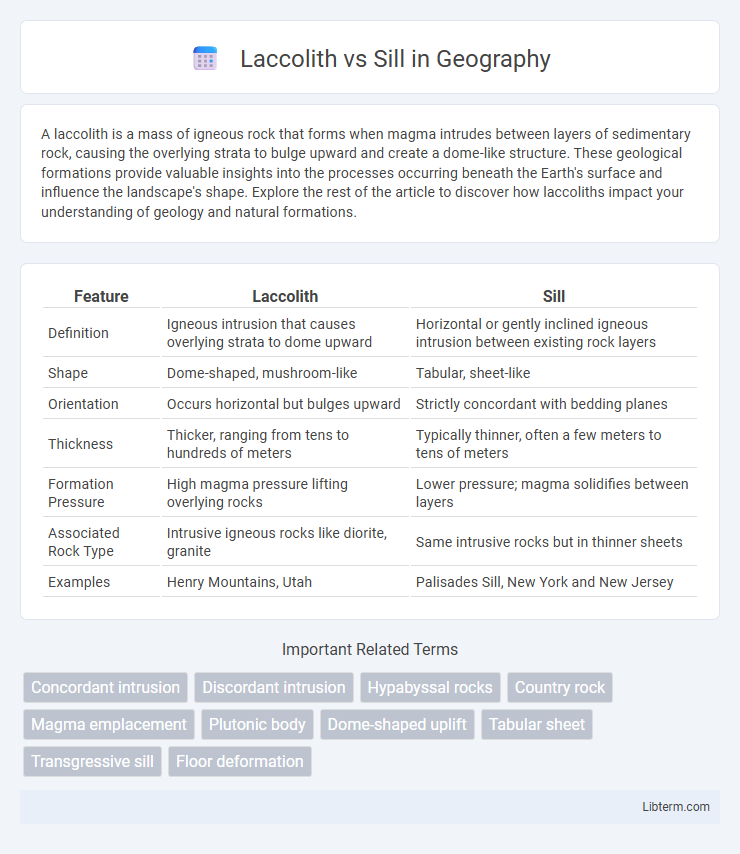A laccolith is a mass of igneous rock that forms when magma intrudes between layers of sedimentary rock, causing the overlying strata to bulge upward and create a dome-like structure. These geological formations provide valuable insights into the processes occurring beneath the Earth's surface and influence the landscape's shape. Explore the rest of the article to discover how laccoliths impact your understanding of geology and natural formations.
Table of Comparison
| Feature | Laccolith | Sill |
|---|---|---|
| Definition | Igneous intrusion that causes overlying strata to dome upward | Horizontal or gently inclined igneous intrusion between existing rock layers |
| Shape | Dome-shaped, mushroom-like | Tabular, sheet-like |
| Orientation | Occurs horizontal but bulges upward | Strictly concordant with bedding planes |
| Thickness | Thicker, ranging from tens to hundreds of meters | Typically thinner, often a few meters to tens of meters |
| Formation Pressure | High magma pressure lifting overlying rocks | Lower pressure; magma solidifies between layers |
| Associated Rock Type | Intrusive igneous rocks like diorite, granite | Same intrusive rocks but in thinner sheets |
| Examples | Henry Mountains, Utah | Palisades Sill, New York and New Jersey |
Introduction to Laccoliths and Sills
Laccoliths are dome-shaped intrusive igneous bodies formed when magma intrudes between rock layers, causing the overlying strata to bulge upwards. Sills are tabular, sheet-like intrusions that form parallel to the existing rock layers without causing significant deformation. Both laccoliths and sills are plutonic features classified based on their geometry and the way magma intrudes surrounding rock formations.
Geological Definitions
A laccolith is a dome-shaped intrusive igneous body that forms when magma injects between sedimentary layers, causing the overlying strata to bulge upward. A sill is a tabular, sheet-like intrusive body that intrudes parallel to preexisting rock layers, typically without significant deformation of the overlying strata. Both laccoliths and sills are types of concordant intrusions but differ in their thickness, shape, and the impact on surrounding rock formations.
Formation Processes
Laccoliths form when viscous magma intrudes between sedimentary rock layers, causing the overlying strata to dome upward due to the pressure. Sills develop as magma intrudes parallel to existing rock layers, solidifying into thin, horizontal sheets without significant deformation of the strata above. The key difference lies in laccoliths creating uplifted, dome-shaped structures, whereas sills remain flat and concordant with surrounding rock layers.
Morphological Differences
Laccoliths are dome-shaped intrusive igneous bodies that cause the overlying strata to arch upward due to magma injection, typically showing a convex upward morphology. In contrast, sills are tabular, sheet-like intrusions that insert themselves parallel to existing rock layers without causing significant deformation or uplift of the overlying strata. Morphologically, laccoliths exhibit a pronounced thickness variation with a bulbous central region, whereas sills maintain relatively uniform thickness and extend laterally along bedding planes.
Depth of Emplacement
Laccoliths are typically emplaced at shallower depths within the Earth's crust, often between 1 to 5 kilometers, where magma intrudes between layers of sedimentary rock and causes vertical uplift, forming a dome-like structure. In contrast, sills form at relatively shallow to moderate depths, commonly less than 3 kilometers, where magma intrudes parallel to existing rock strata without significant deformation of the overlying layers. The depth of emplacement influences their respective geometries, with laccoliths causing notable surface bulging while sills tend to be tabular and concordant intrusions.
Rock Layer Impact
Laccoliths create a dome-shaped uplift by intruding magma between rock layers, causing significant deformation and upward bending of overlying strata. In contrast, sills intrude parallel to existing rock layers without causing substantial deformation, resulting in minimal disruption to the surrounding strata. The distinct rock layer impact differentiates laccoliths, which alter the structural stratigraphy, from sills, which preserve the original layering.
Associated Rock Types
Laccoliths are typically associated with more viscous, felsic to intermediate igneous rocks such as granite, rhyolite, and diorite, which allow the magma to dome the overlying strata. Sills are predominantly composed of mafic to intermediate rocks like basalt and gabbro, formed by magma intruding parallel to sedimentary layers. Both rock formations provide critical insights into the intrusive processes and the thermal history of surrounding sedimentary basins.
Identification in the Field
Laccoliths are identified in the field by their dome-shaped, convex-upward intrusion that causes noticeable uplift in overlying strata, often forming a mushroom-like structure. Sills are recognized as tabular, concordant intrusions that parallel existing sedimentary layers without significantly deforming the overlying rock. Field identification relies on mapping intrusion geometry and contact relationships, with laccoliths showing localized uplift and sills exhibiting sheet-like, stratigraphic concordance.
Examples Around the World
The Henry Mountains in Utah showcase classic laccolith formations formed by magma intrusion pushing overlying strata upward, creating dome-like structures. In contrast, the Palisades Sill along the Hudson River in New York exemplifies a prominent sill, where magma spread horizontally between sedimentary layers, resulting in layered basaltic rock. Other notable laccoliths include the Pine Valley Mountains in Utah and the Bearpaw Mountains in Montana, while famous sills also occur in the Karoo Basin, South Africa, and the Whin Sill in northern England.
Geological Significance and Applications
Laccoliths form when viscous magma intrudes between layers of sedimentary rock, causing a dome-shaped uplift, which significantly impacts the structural geology and topography of an area. Sills are tabular intrusions that inject parallel to sedimentary bedding planes, influencing regional metamorphism and mineralization processes critical for natural resource exploration. Both structures provide valuable insights into magmatic processes and tectonic history, aiding in oil, gas, and mineral exploration through their unique emplacement characteristics.
Laccolith Infographic

 libterm.com
libterm.com